Genome-Wide Identification and Expression Analysis of SWEET Gene Family in Strawberry
Abstract
1. Introduction
2. Materials and Methods
2.1. Identification and Physicochemical Properties Analysis of the SWEET Gene Family
2.2. Phylogenetic Tree Construction
2.3. Chromosome Location and Gene Structure Analysis
2.4. Analysis of Conserved Domains and Conserved Motifs
2.5. Analysis of Promoter Cis-Acting Elements
2.6. Plant Materials and Sugar Treatment
2.7. RT-qPCR Analysis of SWEETs
3. Results
3.1. Identification and Physicochemical Properties Analysis of SWEET of F. × ananassa
3.2. Phylogenetic Tree Construction of F. × ananassa SWEET Family
3.3. Chromosome ‘Location of SWEET Family in F. × ananassa
3.4. Analysis of Conserved Domains and Motifs of the SWEET Family in F. × ananassa
3.5. Analysis of Gene Structure and Promoter Cis-Acting Elements of the SWEET Family of F. × ananassa
3.6. Analysis of FanSWEET Gene Expression
3.6.1. Analysis of FanSWEETs Expression in Different Organs and Fruit Development Stages of Strawberry
3.6.2. Expression of FanSWEETs in Strawberry Fruits Treated with Exogenous Sugar
3.6.3. Expression of FanSWEETs in Strawberry Leaves Treated with Exogenous Sugar
4. Discussion
4.1. Bioinformatics Analysis of FanSWEET Gene Family
4.2. Expression of FanSWEET Genes in Strawberry
4.3. Effect of Exogenous Sugar Treatments on the Expression of FanSWEETs
5. Conclusions
Supplementary Materials
Author Contributions
Funding
Data Availability Statement
Conflicts of Interest
References
- Braun, D.M.; Wang, L.; Ruan, Y.L. Understanding and manipulating sucrose phloem loading, unloading, metabolism, and signalling to enhance crop yield and food security. J. Exp. Bot. 2014, 65, 1713–1735. [Google Scholar] [CrossRef]
- Filip, R.; Jen, S. Sugar sensing and signalling networks in plants. Biochem. Soc. Trans. 2005, 33, 269–271. [Google Scholar]
- Gibson, S.I. Control of plant development and gene expression by sugar signaling. Curr. Opin. Plant Biol. 2005, 8, 93–102. [Google Scholar] [CrossRef]
- Eom, J.S.; Chen, L.Q.; Sosso, D.; Julius, B.T.; Lin, I.W.; Qu, X.Q.; Braun, D.M.; Frommer, W.B. SWEETs, transporters for intracellular and intercellular sugar translocation. Curr. Opin. Plant Biol. 2015, 25, 53–62. [Google Scholar] [CrossRef]
- Lalonde, S.; Lalonde, D.; Frommer, W.B. Transport mechanisms for organic forms of carbon and nitrogen between sotrce and sink. Annu. Rev. Plant Biol. 2004, 55, 341–372. [Google Scholar] [CrossRef]
- Liu, H.T.; Ji, Y.; Liu, Y.; Tian, S.H.; Duan, K.; Zou, X.H.; Yang, J.; Dong, C.; Gao, Q.H. The sugar transporter system of strawberry: Genome-wide identification and expression correlation with fruit soluble sugar-related traits in Fragaria × ananassa Duchesne germplasms collection. Acta Hortic. 2021, 1309, 223–233. [Google Scholar] [CrossRef]
- Yang, C.; Zhao, X.; Luo, Z.; Wang, L.H.; Liu, M.J. Genome-wide identification and expression profile analysis of SWEET genes in Chinese jujube. PeerJ 2023, 22, e14704. [Google Scholar] [CrossRef] [PubMed]
- Thomas, L.S. Diverse functional roles of monosaccharide transporters and their homologs in vascular plants: A physiological perspective. Mol. Plant. 2011, 4, 641–662. [Google Scholar]
- Brian, G.A. Membrane-transport systems for sucrose in relation to whole-plant carbon partitioning. Mol. Plant 2011, 4, 377–394. [Google Scholar]
- Chen, L.Q.; Hou, B.H.; Lalonde, S.; Takanaga, H.; Hartung, M.L.; Qu, X.Q.; Guo, W.J.; Kim, J.G.; Underwood, W.; Chaudhuri, B.; et al. Sugar transporters for intercellular exchange and nutrition of pathogens. Nature 2010, 468, 527–532. [Google Scholar] [CrossRef]
- Tao, Y.Y.; Cheung, L.S.; Li, S.; Eom, J.S.; Chen, L.Q.; Xu, Y.; Perry, K.; Frommer, W.B.; Feng, L. Structure of a eukaryotic SWEET transporter in a homotrimeric complex. Nature 2015, 527, 259–263. [Google Scholar] [CrossRef] [PubMed]
- Chen, L.Q.; Lin, I.W.; Qu, X.Q.; Sosso, D.; McFarlane, H.E.; Londoño, A.; Samuels, A.L.; Frommer, W.B. A cascade of sequentially expressed sucrose transporters in the seed coat and endosperm provides nutrition for the Arabidopsis embryo. Plant Cell. 2015, 27, 607–619. [Google Scholar] [CrossRef] [PubMed]
- Lin, I.W.; Sosso, D.; Chen, L.Q.; Gase, K.; Kim, S.G.; Kessler, D.; Klinkenberg, P.M.; Gorder, M.K.; Hou, B.H.; Qu, X.Q.; et al. Nectar secretion requires sucrose phosphate synthases and the sugar transporter SWEET9. Nature 2014, 508, 546–549. [Google Scholar] [CrossRef]
- Jeena, G.S.; Kumar, S.; Shukla, R.K. Structure, evolution and diverse physiological roles of SWEET sugar transporters in plants. Plant Mol. Biol. 2019, 100, 351–365. [Google Scholar] [CrossRef]
- Streubel, J.; Pesce, C.; Hutin, M.; Koebnik, R.; Boch, J.; Szurek, B. Five phylogenetically close rice SWEET genes confer TAL effector-mediated susceptibility to Xanthomonas oryzae pv. oryzae. New Phytol. 2013, 200, 303–819. [Google Scholar] [CrossRef]
- Yuan, M.; Wang, S.P. Rice MtN3/saliva/SWEET Family genes and their homologs in cellular organisms. Mol. Plant. 2013, 6, 665–674. [Google Scholar] [CrossRef] [PubMed]
- Zhu, J.L.; Zhou, L.; Li, T.F.; Ruan, Y.Y.; Zhang, A.; Dong, X.M.; Zhu, Y.S.; Li, C.; Fan, J.J. Genome-wide investigation and characterization of SWEET gene family with focus on their evolution and expression during hormone and abiotic stress response in maize. Genes 2022, 133, 1682. [Google Scholar] [CrossRef]
- Feng, C.Y.; Han, J.X.; Han, X.X.; Jiang, J. Genome-wide identification, phylogeny, and expression analysis of the SWEET gene family in tomato. Gene 2015, 573, 261–272. [Google Scholar] [CrossRef]
- Miao, L.M.; Lv, Y.X.; Kong, L.J.; Chen, Q.Z.; Chen, C.Q.; Li, J.; Zeng, F.H.; Wang, S.Y.; Li, J.B.; Huang, L.; et al. Genome-wide identification, phylogeny, evolution, and expression patterns of MtN3/saliva/SWEET genes and functional analysis of BcNS in Brassica rapa. BMC Genom. 2018, 19, 174. [Google Scholar] [CrossRef]
- Filyushin, M.A.; Anisimova, O.K.; Shchennikova, A.V.; Kochieva, E.Z. Genome-wide identification, expression, and response to fusarium infection of the SWEET gene family in garlic (Allium sativum L.). Int. J. Mol. Sci. 2023, 24, 7533. [Google Scholar] [CrossRef]
- Chong, J.; Piron, M.C.; Meyer, S.; Merdinoglu, D.; Bertsch, C.; Mestre, P. The SWEET family of sugar transporters in grapevine: VvSWEET4 is involved in the interaction with Botrytis cinerea. J. Exp. Bot. 2014, 65, 6589–6601. [Google Scholar] [CrossRef] [PubMed]
- Wei, X.Y.; Liu, F.L.; Chen, C.; Ma, F.W.; Li, M.J. The Malus domestica sugar transporter gene family: Identifications based on genome and expression profiling related to the accumulation of fruit sugars. Front. Plant Sci. 2014, 5, 569. [Google Scholar] [CrossRef]
- Xie, H.H.; Wang, D.; Qin, Y.Q.; Ma, A.; Fu, J.X.; Qin, Y.H.; Hu, G.B.; Zhao, J.T. Genome-wide identification and expression analysis of SWEET gene family in Litchi chinensis reveal the involvement of LcSWEET2a/3b in early seed development. BMC Plant Biol. 2019, 19, 499. [Google Scholar] [CrossRef] [PubMed]
- Xuan, C.Q.; Lan, G.P.; Si, F.F.; Zeng, Z.L.; Wang, C.X.; Yadav, V.; Wei, C.H.; Zhang, X. Systematic genome-wide study and expression analysis of SWEET gene family: Sugar transporter family contributes to biotic and abiotic stimuli in watermelon. Int. J. Mol. Sci. 2021, 22, 8407. [Google Scholar] [CrossRef] [PubMed]
- Fang, T.; Rao, Y.; Wang, M.Z.; Li, Y.; Liu, Y.J.; Xiong, P.P.; Zeng, L.H. Characterization of the SWEET gene family in Longan (Dimocarpus longan) and the role of DlSWEET1 in cold tolerance. Int. J. Mol. Sci. 2013, 23, 697–702. [Google Scholar] [CrossRef]
- Lu, C.; Ye, J.; Chang, Y.Q.; Mi, Z.Y.; Liu, S.; Wang, D.H.; Wang, Z.Z.; Niu, J.F. Genome-wide identification and expression patterns of the SWEET gene family in Bletilla striata letilla striata and its responses to low temperature and oxidative stress. Int. J. Mol. Sci. 2022, 23, 10057. [Google Scholar] [CrossRef]
- Hao, L.; Shi, X.; Qin, S.W.; Dong, J.H.; Shi, H.; Wang, Y.H.; Zhang, Y. Genome-wide identification, characterization and transcriptional profile of the SWEET gene family in Dendrobium officinale. BMC Genom. 2023, 24, 378. [Google Scholar] [CrossRef]
- Song, X.S.; Kou, Y.Q.; Duan, M.G.; Feng, B.; Yu, X.Y.; Jia, R.D.; Zhao, X.; Ge, H.; Yang, S.H. Genome-wide identification of the rose SWEET gene family and their different expression profiles in cold response between two rose species. Plants 2023, 12, 1474. [Google Scholar] [CrossRef]
- Chen, L.Q.; Qu, X.Q.; Hou, B.H.; Sosso, D.; Osorio, S.; Fernie, A.R.; Frommer, W.B. Sucrose efflux mediated by SWEET proteins as a key step for phloem transport. Science 2012, 335, 207–211. [Google Scholar] [CrossRef]
- Chen, L.Q. SWEET sugar transporters for phloem transport and pathogen nutrition. New Phytol. 2014, 201, 1150–1155. [Google Scholar] [CrossRef]
- Guo, W.J.; Nagy, R.; Chen, H.Y.; Pfrunder, S.; Yu, Y.C.; Santelia, D.; Frommer, W.B.; Martinoia, E. SWEET17, a facilitative transporter, mediates fructose transport across the tonoplast of Arabidopsis roots and leaves. Plant Physiol. 2014, 164, 777–789. [Google Scholar] [CrossRef] [PubMed]
- Klemens, P.A.W.; Patzke, K.; Deitmer, J.; Spinner, L.; Le, H.R.; Bellini, C.; Bedu, M.; Chardon, F.; Krapp, A.; Neuhaus, H.E. Overexpression of the vacuolar sugar carrier AtSWEET16 modifies germination, growth, and stress tolerance in Arabidopsis. Plant Physiol. 2013, 163, 1338–1352. [Google Scholar] [CrossRef] [PubMed]
- Sun, M.X.; Huang, X.Y.; Yang, J.; Guan, Y.F.; Yang, Z.N. Arabidopsis RPG1 is important for primexine deposition and functions redundantly with RPG2 for plant fertility at the late reproductive stage. Plant Reprod. 2013, 26, 83–91. [Google Scholar] [CrossRef] [PubMed]
- Chardon, F.; Bedu, M.; Calenge, F.; Klemens, P.A.; Spinner, L.; Clement, G.; Chietera, G.; Leran, S.; Ferrand, M.; Lacombe, B.; et al. Leaf fructose content is controlled by the vacuolar transporter SWEET17 in Arabidopsis. Curr. Biol. 2013, 23, 697–702. [Google Scholar] [CrossRef] [PubMed]
- Chen, H.Y.; Huh, J.H.; Yu, Y.C.; Ho, L.H.; Chen, L.Q.; Tholl, D.; Frommer, W.B.; Guo, W.J. The Arabidopsis vacuolar sugar transporter SWEET2 limits carbon sequestration from roots and restricts Pythium infection. Plant J. Cell Mol. Biol. 2015, 83, 1046–1058. [Google Scholar] [CrossRef] [PubMed]
- Kanno, Y.; Oikawa, T.; Chiba, Y.; Ishimaru, Y.; Shimizu, T.; Sano, N.; Koshiba, T.; Kamiya, Y.; Ueda, M.; Seo, M. AtSWEET13 and AtSWEET14 regulate gibberellin-mediated physiological processes. Nat. Commun. 2016, 7, 13245. [Google Scholar] [CrossRef]
- Ma, L.; Zhang, D.C.; Miao, Q.S.; Yang, J.; Xuan, Y.H.; Hu, Y.B. Essential role of sugar transporter OsSWEET11 during the early stage of rice grain filling. Plant Cell Physiol. 2017, 58, 863–873. [Google Scholar] [CrossRef]
- Morii, M.; Sugihara, A.; Takehara, S.; Kanno, Y.; Kawai, K.; Hobo, T.; Hattori, M.; Yoshimura, H.; Seo, M.; UeguchiTanaka, M. The dual function of OsSWEET3a as a gibberellin and glucose transporter is important for young shoot development in rice. Plant Cell Physiol. 2020, 61, 1935–1945. [Google Scholar] [CrossRef]
- Zhou, Y.; Liu, L.; Huang, W.F.; Yuan, M.; Zhou, F.; Li, X.H.; Lin, Y.J. Overexpression of OsSWEET5 in rice causes growth retardation and precocious senescence. PLoS ONE 2014, 9, e94210. [Google Scholar] [CrossRef]
- Ho, L.H.; Klemens, P.A.W.; Neuhaus, H.E.; Ko, H.Y.; Hsieh, S.Y.; Guo, W.J. SlSWEET1a is involved in glucose import to young leaves in tomato plants. J. Exp. Bot. 2019, 70, 3241–3254. [Google Scholar] [CrossRef]
- Redondo-Nieto, M.; Maunoury, N.; Mergaert, P.; Kondorosi, E.; Bonilla, I.; Bolaños, L. Boron and calcium induce major changes in gene expression during legume nodule organogenesis. Does boron have a role in signalling? New Phytol. 2012, 195, 24–29. [Google Scholar] [CrossRef] [PubMed]
- Seo, P.J.; Park, J.M.; Kang, S.K.; Kim, S.G.; Park, C.M. An Arabidopsis senescence-associated protein SAG29 regulates cell viability under high salinity. Planta 2011, 233, 189–200. [Google Scholar] [CrossRef] [PubMed]
- Huang, D.M.; Chen, Y.; Liu, X.; Ni, D.A.; Bai, L.; Qin, Q.P. Genome-wide identification and expression analysis of the SWEET gene family in daylily (Hemerocallis fulva) and functional analysis of HfSWEET17 in response to cold stress. BMC Plant Biol. 2022, 22, 211. [Google Scholar] [CrossRef] [PubMed]
- Liu, Z.C.; Liang, T.; Kang, C.Y. Molecular bases of strawberry fruit quality traits: Advances, challenges, and opportunities. Plant Physiol. 2023, 193, 900–914. [Google Scholar] [CrossRef] [PubMed]
- Liu, T.J.; Li, M.Z.; Liu, Z.H.; Ai, X.Y.; Li, Y.P. Reannotation of the cultivated strawberry genome and establishment of a strawberry genome database. Hortic. Res. 2021, 8, 41. [Google Scholar] [CrossRef] [PubMed]
- Wang, L.Q.; Guo, K.; Li, Y.; Tu, Y.Y.; Hu, H.Z.; Wang, B.R.; Cui, X.C.; Peng, L.C. Expression profiling and integrative analysis of the CESA/CSL superfamily in rice. BMC Plant Biol. 2010, 10, 57. [Google Scholar] [CrossRef]
- Breia, R.; Conde, A.; Badim, H.; Fortes, A.M.; Gerós, H.; Granell, A. Plant SWEETs: From sugar transport to plant-pathogen interaction and more unexpected physiological roles. Plant Physiol. 2021, 186, 836–852. [Google Scholar] [CrossRef]
- Li, J.M.; Qin, M.F.; Qiao, X.; Chen, Y.S.; Li, X.L.; Zhang, H.Q.; Wu, J. A new insight into the evolution and functional divergence of SWEET transporters in chinese white pear (Pyrus bretschneideri). Plant Cell Physiol. 2017, 58, 839–850. [Google Scholar] [CrossRef]
- Patil, G.; Valliyodan, B.; Deshmukh, R.; Prince, S.; Nicander, B.; Zhao, M.; Sonah, H.; Song, L.; Lin, L.; Chaudhary, J.; et al. Soybean (Glycine max) SWEET gene family: Insights through comparative genomics, transcriptome profiling and whole genome re-sequence analysis. BMC Genom. 2015, 16, 520. [Google Scholar] [CrossRef]
- Gasteiger, E.; Hoogland, C.; Gattiker, A. Protein identification and analysis tools on the ExPASy server. In The Proteomics Protocols Handbook; Humana Press: Totowa, NJ, USA, 2005; pp. 571–607. [Google Scholar]
- Hu, Y.B.; Sosso, D.; Qu, X.Q.; Chen, L.Q.; Ma, L.; Chermak, D.; Zhang, D.C.; Frommer, W.B. Phylogenetic evidence for a fusion of archaeal and bacterial SemiSWEETs to form eukaryotic SWEETs and identification of SWEET hexose transporters in the amphibian chytrid pathogen Batrachochytrium dendrobatidis. FASEB J. Off. Publ. Fed. Am. Soc. Exp. Biol. 2016, 30, 3644–3654. [Google Scholar] [CrossRef] [PubMed]
- Xuan, Y.H.; Hu, Y.B.; Chen, L.Q.; Sosso, D.; Ducat, D.C.; Hou, B.H.; Frommer, W.B. Functional role of oligomerization for bacterial and plant SWEET sugar transporter family. Proc. Natl. Acad. Sci. USA 2013, 110, E3685–E3694. [Google Scholar] [CrossRef]
- Severin, A.J.; Cannon, S.B.; Graham, M.M.; Grant, D.; Shoemaker, R.C. Changes in twelve homoeologous genomic regions in soybean following three rounds of polyploidy. Plant Cell. 2011, 23, 3129–3136. [Google Scholar] [CrossRef]
- Soltis, D.E.; Visger, C.J.; Soltis, P.S. The polyploidy revolution then… and now: Stebbins revisited. Am. J. Bot. 2014, 101, 1057–1078. [Google Scholar] [CrossRef]
- Nie, P.X.; Xu, G.X.; Yu, B.; Lv, D.G.; Xue, X.M.; Qin, S.J. Genome-wide identification and expression profiling reveal the potential functions of the SWEET gene family during the sink organ development period in apple (Malus × domestica Borkh.). Agronomy 2022, 12, 1747. [Google Scholar] [CrossRef]
- Li, Y.X.; Feng, S.; Ma, S.; Sui, X.L.; Zhang, Z.X. Spatiotemporal expression and substrate specificity analysis of the cucumber SWEET gene family. Front. Plant Sci. 2017, 8, 1855. [Google Scholar] [CrossRef] [PubMed]
- Chen, L.Q.; Cheung, L.S.; Feng, L.; Tanner, W.; Frommer, W.B. Transport of sugars. Annu. Rev. Biochem. 2015, 848, 865–894. [Google Scholar] [CrossRef] [PubMed]
- Liu, B.; Du, H.W.; Rutkowski, R.; Gartner, A.; Wang, X.C. LAAT-1 is the lysosomal lysine/arginine transporter that maintains amino acid homeostasis. Science 2012, 337, 351–354. [Google Scholar] [CrossRef] [PubMed]
- Collis, S.J.; DeWeese, T.L.; Jeggo, P.A.; Parker, A.R. The life and death of DNA-PK. Oncogene 2005, 24, 949–961. [Google Scholar] [CrossRef] [PubMed]
- Mukherjee, D.; Saha, D.; Acharya, D.; Mukherjee, A.; Chakraborty, S.; Ghosh, T.C. The role of introns in the conservation of the metabolic genes of Arabidopsis thaliana. Genomics 2018, 110, 310–317. [Google Scholar] [CrossRef] [PubMed]
- Morello, L.; Giani, S.; Troina, F.; Breviario, D. Testing the IMEter on rice introns and other aspects of intron-mediated enhancement of gene expression. J. Exp. Bot. 2011, 62, 533–544. [Google Scholar] [CrossRef] [PubMed]
- Ko, H.Y.; Ho, L.; Neuhaus, H.E.; Guo, W. Transporter SlSWEET15 unloads sucrose from phloem and seed coat for fruit and seed development in tomato. Plant Physiol. 2021, 187, 2230–2245. [Google Scholar] [CrossRef]
- Li, J.; Chen, D.; Jiang, G.L.; Song, H.Y.; Tu, M.Y.; Sun, S.X. Molecular cloning and expression analysis of EjSWEET15, enconding for a sugar transporter from loquat. Sci. Hortic. 2020, 272, 109552. [Google Scholar] [CrossRef]
- Baker, R.F.; Leach, K.A.; Braun, D.M. SWEET as sugar: New sucrose effluxers in plants. Mol. Plant. 2012, 5, 766–768. [Google Scholar] [CrossRef]
- Verdier, V.; Triplett, L.R.; Hummel, A.W.; Corral, R.; Cernadas, R.A.; Schmidt, C.L.; Bogdanove, A.J.; Leach, J.E. Transcription activator-like (TAL) effectors targeting OsSWEET genes enhance virulence on diverse rice (Oryza sativa) varieties when expressed individually in a TAL effector-deficient strain of Xanthomonas oryzae. New Phytol. 2012, 196, 1197–1207. [Google Scholar] [CrossRef] [PubMed]
- Guo, C.Y.; Li, H.Y.; Xia, X.Y.; Liu, X.Y.; Yang, L. Functional and evolution characterization of SWEET sugar transporters in Ananas comosus. Biochem. Biophys. Res. Commun. 2018, 496, 407–414. [Google Scholar] [CrossRef] [PubMed]
- Yuan, J.P.; Liu, T.K.; Yu, Z.H.; Li, Y.; Ren, H.B.; Hou, X.L.; Li, Y. Genome-wide analysis of the Chinese cabbage IQD gene family and the response of BrIQD5 in drought resistance. Plant Mol. Biol. 2019, 99, 603–620. [Google Scholar] [CrossRef] [PubMed]
- Li, C.Y.; Shi, J.X.; Weiss, D.; Goldschmidt, E.E. Sugars regulate sucrose transporter gene expression in citrus. Biochem. Biophys. Res. Commun. 2003, 306, 402–407. [Google Scholar] [CrossRef]
- Xue, J.Q.; Tang, Y.; Wang, S.L.; Yang, R.W.; Xue, Y.Q.; Wu, C.H.; Zhang, X.X. Assessment of vase quality and transcriptional regulation of sucrose transporter and invertase genes in cut peony (Paeonia lactiflora ‘Yang Fei Chu Yu’) treated by exogenous sucrose. Postharvest Biol. Technol. 2018, 143, 92–101. [Google Scholar] [CrossRef]
- Sakr, S.; Wang, M.; Dédaldéchamp, F.; Perez-Garcia, M.D.; Ogé, L.; Hamama, L.; Atanassov, R. The sugar-signaling hub: Overview of regulators and interaction with the hormonal and metabolic network. Int. J. Mol. Sci. 2018, 19, 2506. [Google Scholar] [CrossRef]
- Jia, H.F.; Wang, Y.H.; Sun, M.Z.; Li, B.B.; Han, Y.; Zhao, Y.X.; Jia, W.S. Sucrose functions as a signal involved in the regulation of strawberry fruit development and ripening. New Phytol. 2013, 198, 453–465. [Google Scholar] [CrossRef]

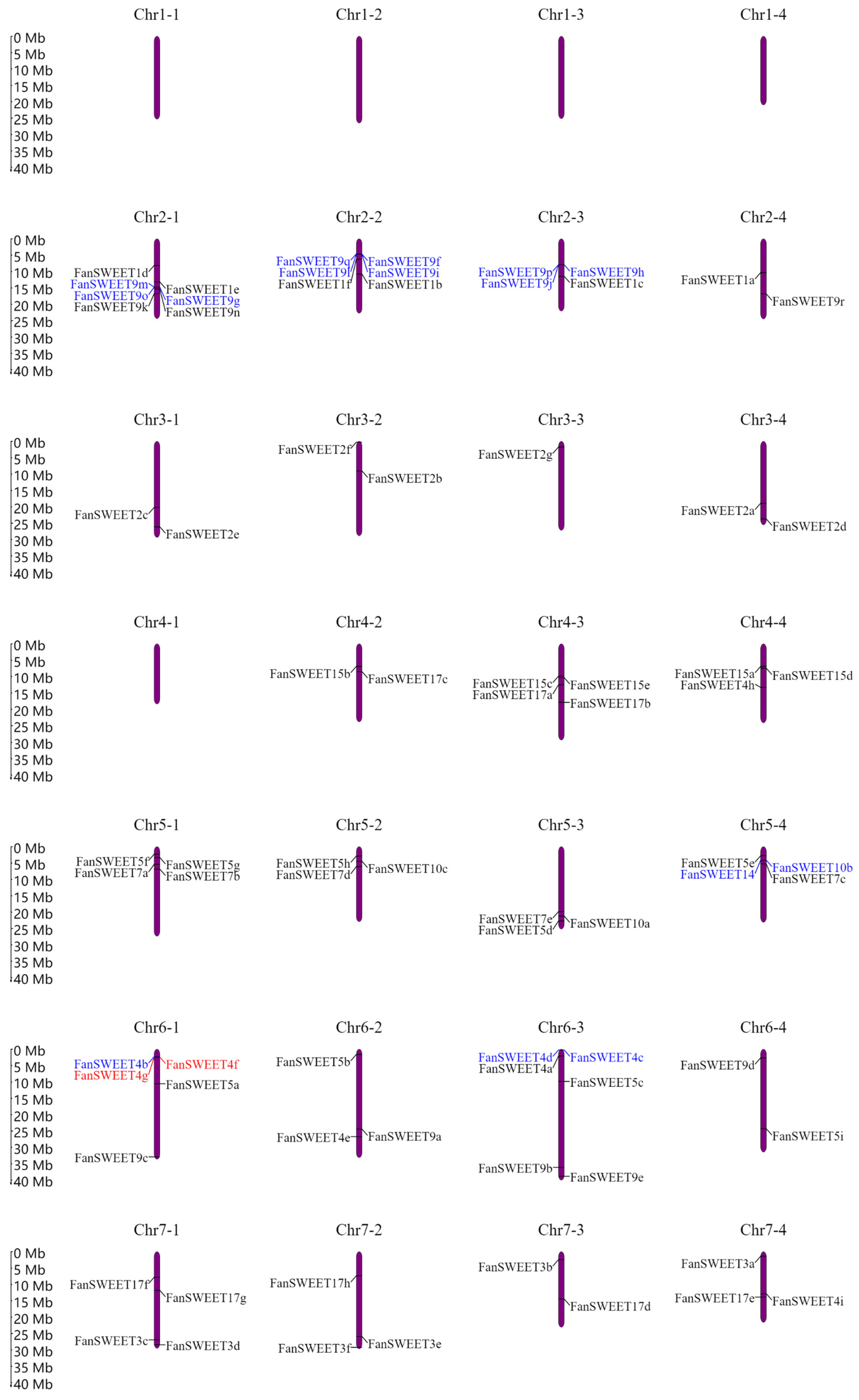

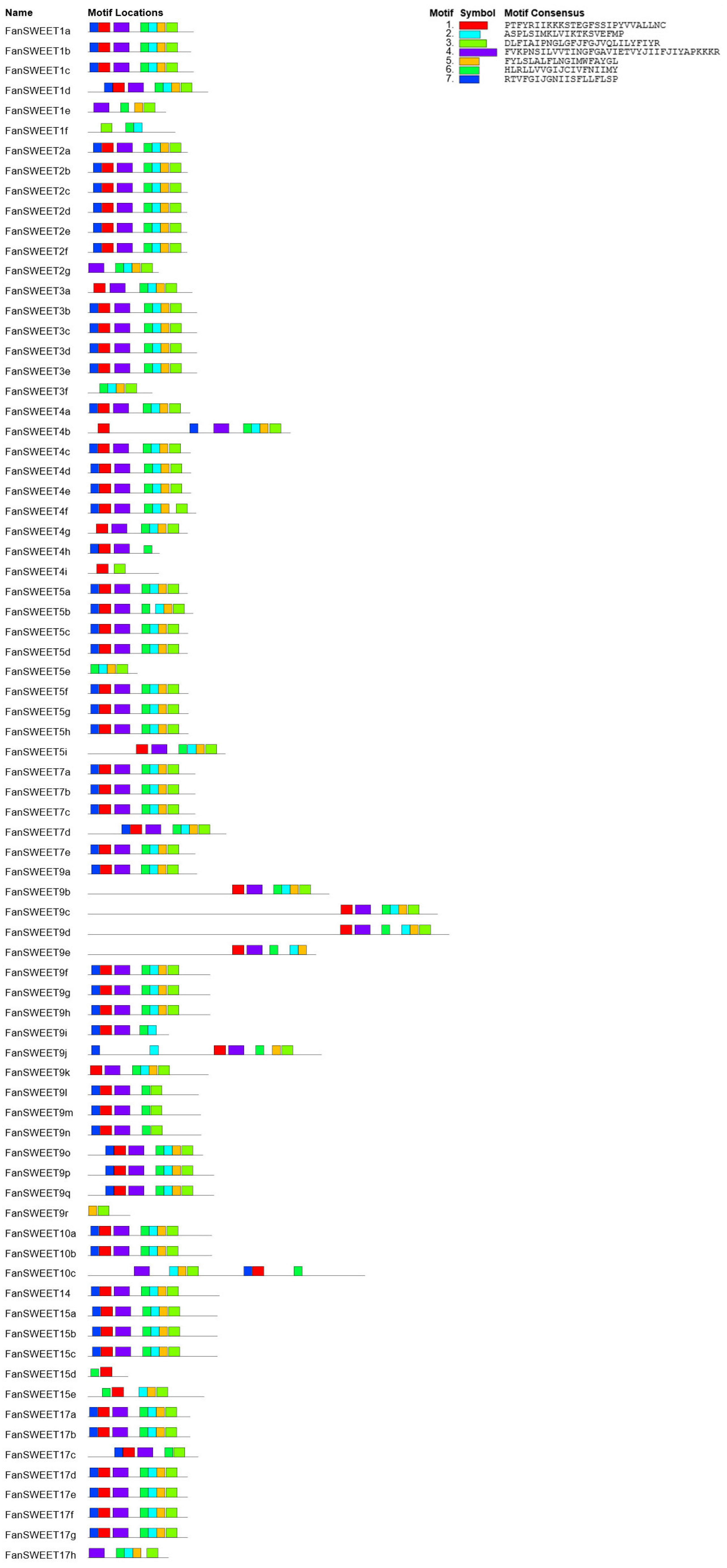
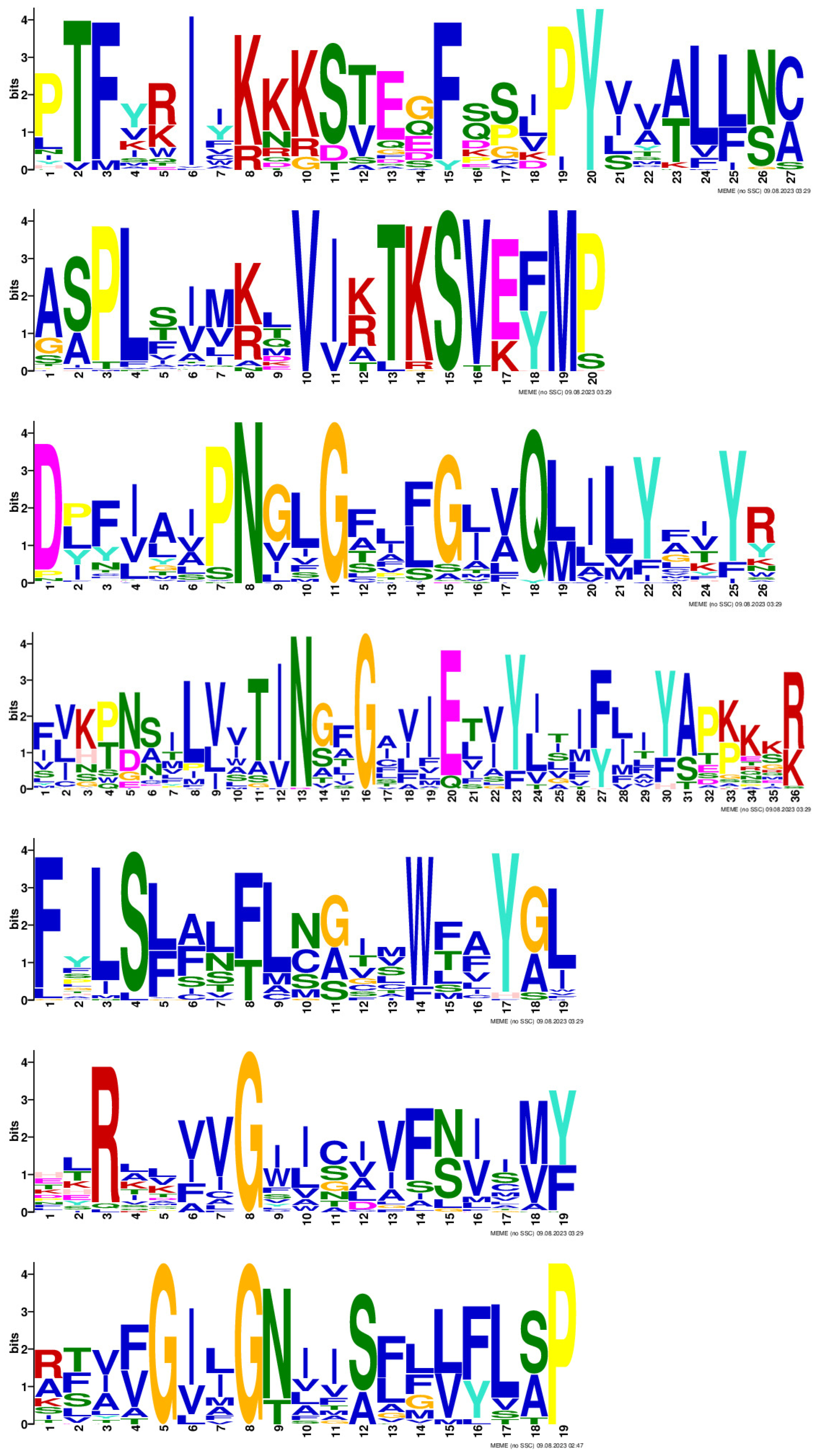
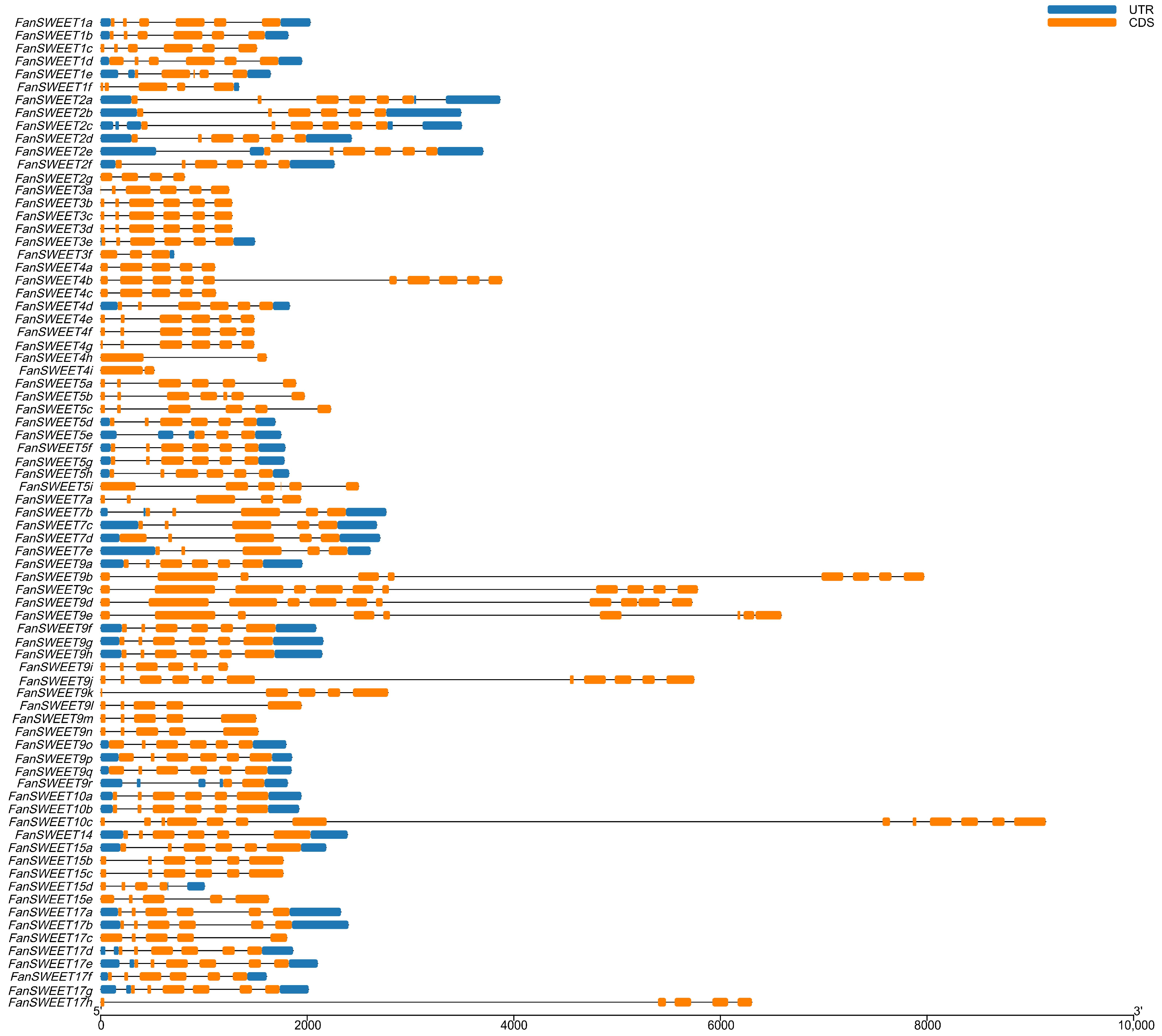
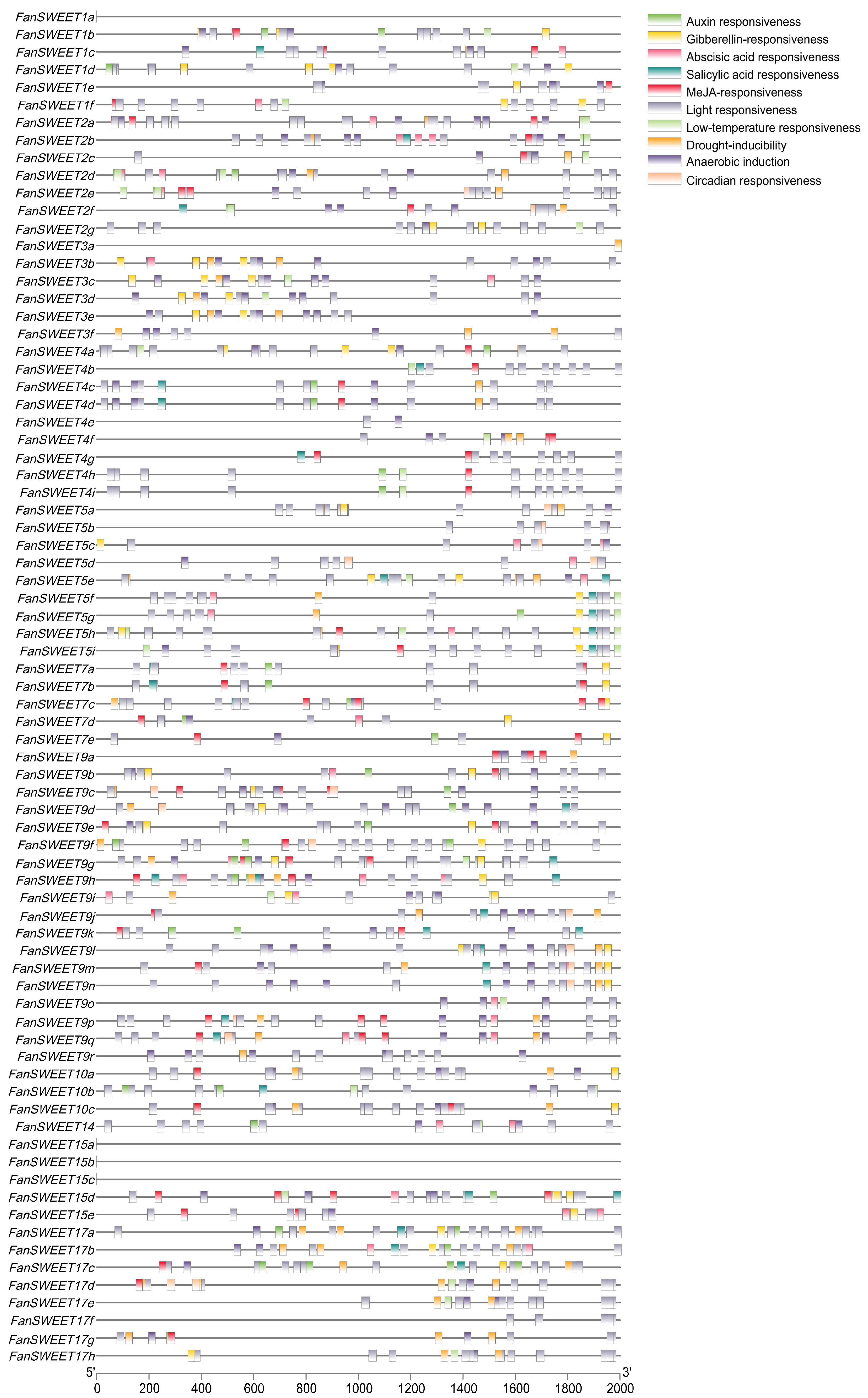
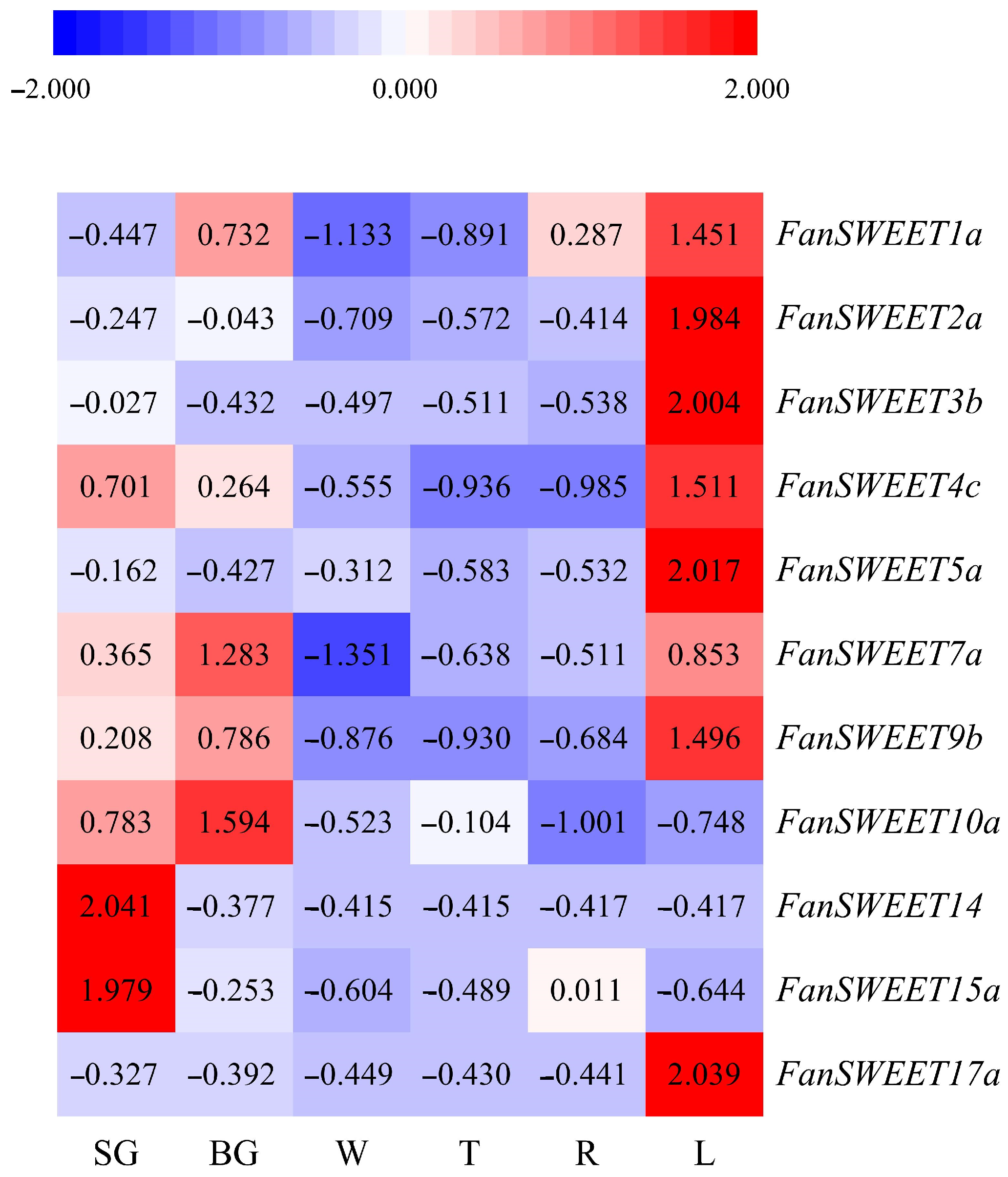
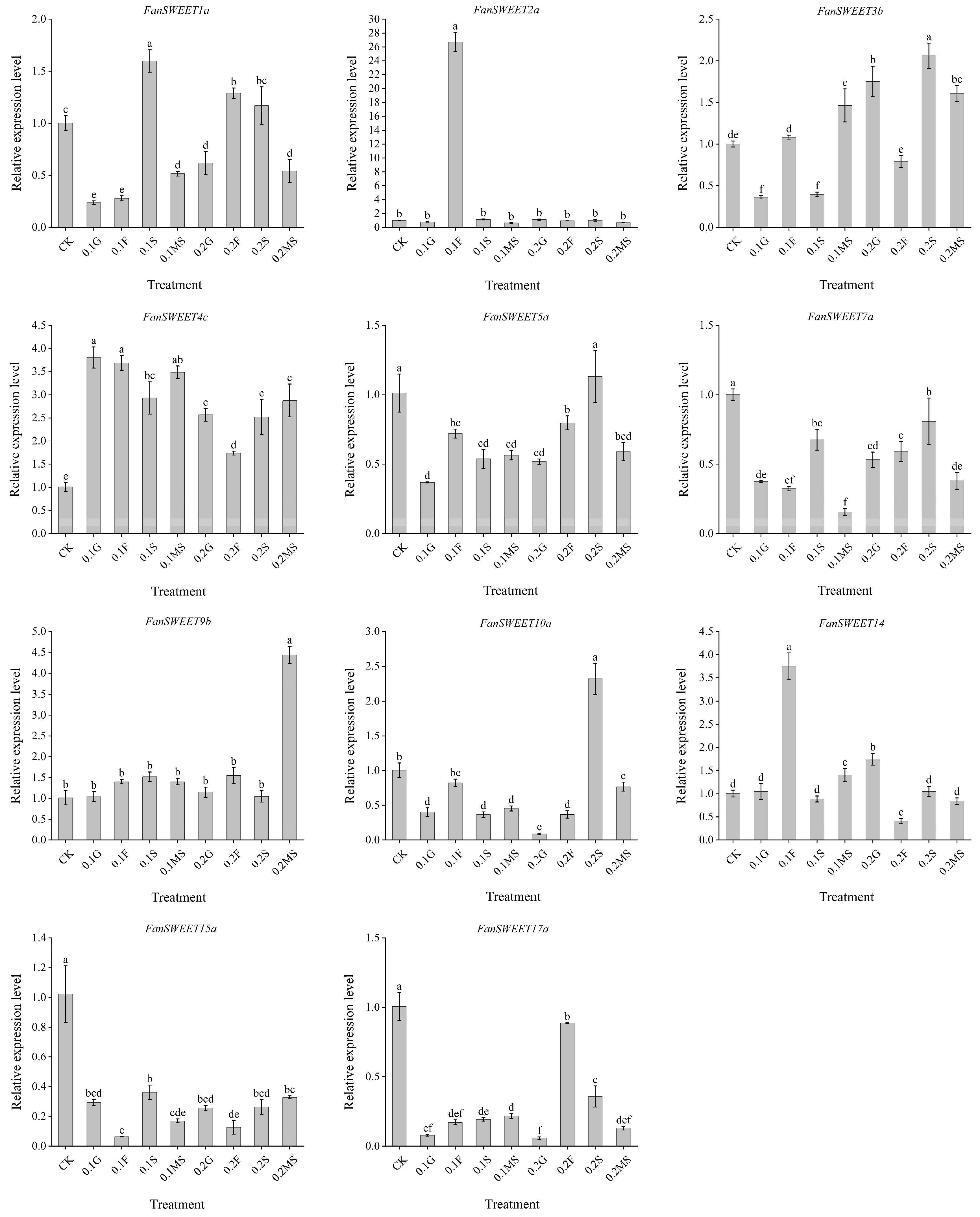
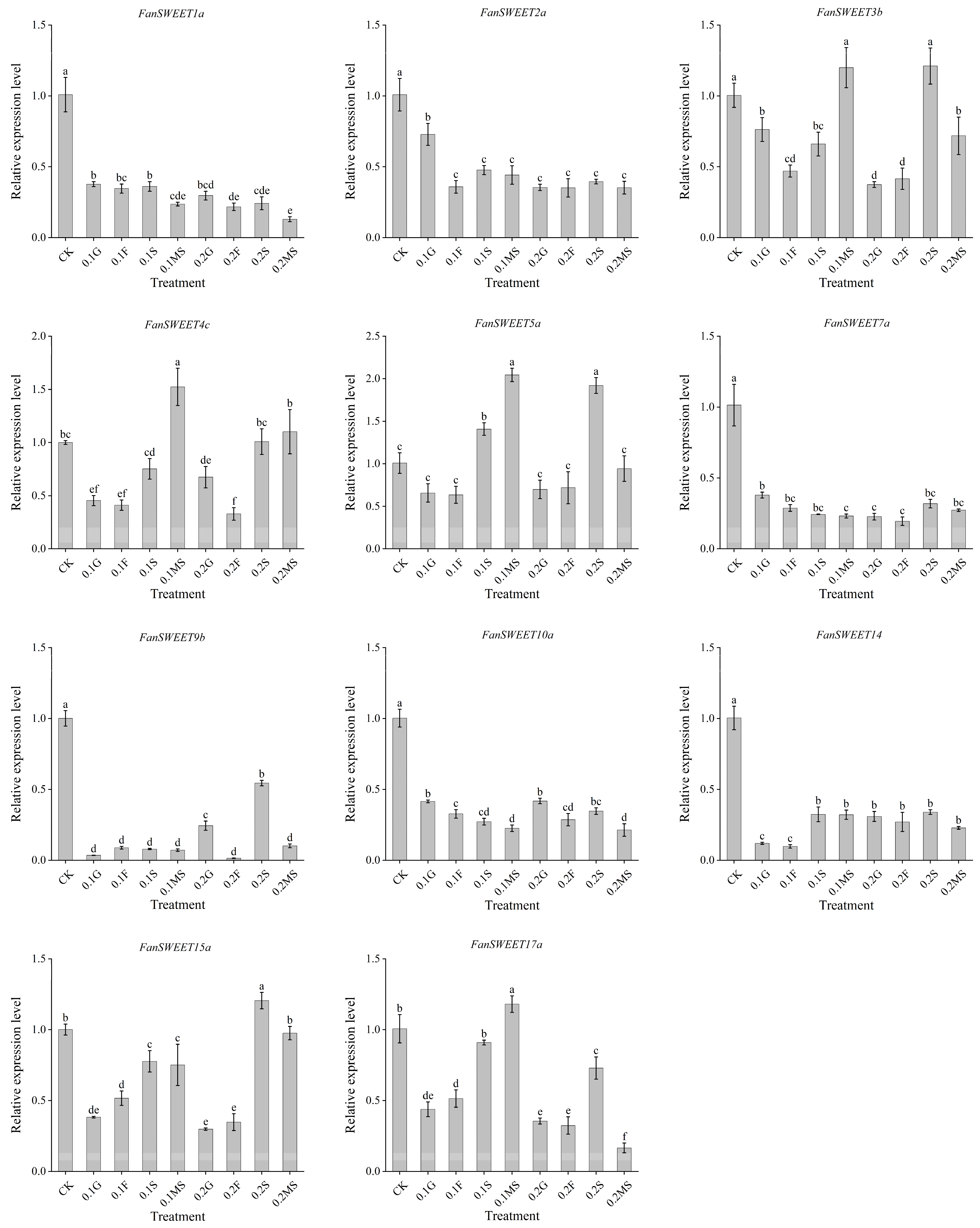
| Treatment Code | Treatment Combination |
|---|---|
| CK | Water |
| 0.1 G | 0.1 mol∙L−1 glucose |
| 0.1 F | 0.1 mol∙L−1 fructose |
| 0.1 S | 0.1 mol∙L−1 sucrose |
| 0.1 MS | 0.1 mol∙L−1 mixed sugar |
| 0.2 G | 0.2 mol∙L−1 glucose |
| 0.2 F | 0.2 mol∙L−1 fructose |
| 0.2 S | 0.2 mol∙L−1 sucrose |
| 0.2 MS | 0.2 mol∙L−1 mixed sugar |
| Gene ID | Gene Name | Number of Amino Acid (aa) | Number of Predicted TMs | Molecular Weight (kD) | Theoretical pI | Average Hydrophobicity Index | Instability Index | Aliphatic Index | Subcellular Localization |
|---|---|---|---|---|---|---|---|---|---|
| FxaC_6g17780.t1 | FanSWEET1a | 249 | 7 | 27.327 | 9.37 | 0.612 | 36.92 | 106.02 | plas |
| FxaC_5g24000.t1 | FanSWEET1b | 243 | 7 | 26.752 | 9.28 | 0.696 | 37.28 | 107.86 | plas |
| FxaC_8g24010.t1 | FanSWEET1c | 249 | 7 | 27.236 | 9.26 | 0.616 | 36.54 | 104.86 | plas |
| FxaC_7g12850.t1 | FanSWEET1d | 283 | 7 | 30.920 | 9.25 | 0.578 | 40.37 | 104.66 | plas |
| FxaC_7g21380.t1 | FanSWEET1e | 184 | 5 | 19.885 | 5.23 | 0.770 | 26.62 | 104.84 | plas |
| FxaC_5g14330.t1 | FanSWEET1f | 206 | 3 | 22.683 | 9.61 | 0.524 | 34.15 | 95.00 | chlo |
| FxaC_9g37270.t1 | FanSWEET2a | 235 | 7 | 26.246 | 9.04 | 0.865 | 45.42 | 121.15 | plas |
| FxaC_10g18570.t1 | FanSWEET2b | 235 | 7 | 26.305 | 9.02 | 0.837 | 45.58 | 118.64 | plas |
| FxaC_12g32490.t1 | FanSWEET2c | 235 | 7 | 26.179 | 8.93 | 0.838 | 41.80 | 121.15 | plas |
| FxaC_9g48290.t1 | FanSWEET2d | 234 | 7 | 26.344 | 8.95 | 0.935 | 38.05 | 130.77 | vacu |
| FxaC_12g43600.t1 | FanSWEET2e | 234 | 7 | 26.314 | 9.03 | 0.965 | 38.05 | 131.97 | vacu |
| FxaC_10g00470.t1 | FanSWEET2f | 234 | 7 | 26.300 | 9.03 | 0.956 | 38.88 | 131.58 | vacu |
| FxaC_11g04070.t1 | FanSWEET2g | 167 | 5 | 18.773 | 8.95 | 1.034 | 33.96 | 139.40 | vacu |
| FxaC_28g03100.t1 | FanSWEET3a | 246 | 6 | 27.697 | 8.82 | 0.539 | 42.52 | 112.07 | plas |
| FxaC_26g05400.t1 | FanSWEET3b | 257 | 7 | 28.775 | 9.13 | 0.581 | 40.85 | 115.21 | plas |
| FxaC_27g47490.t1 | FanSWEET3c | 257 | 7 | 28.869 | 8.99 | 0.538 | 39.72 | 111.44 | plas |
| FxaC_27g50800.t1 | FanSWEET3d | 257 | 7 | 28.869 | 8.99 | 0.538 | 39.72 | 111.44 | plas |
| FxaC_25g53100.t1 | FanSWEET3e | 257 | 7 | 28.914 | 9.14 | 0.549 | 41.56 | 112.57 | plas |
| FxaC_25g61070.t1 | FanSWEET3f | 152 | 4 | 17.099 | 8.71 | 0.474 | 43.96 | 108.22 | chlo |
| FxaC_22g04470.t1 | FanSWEET4a | 241 | 7 | 26.733 | 8.80 | 0.761 | 29.47 | 116.76 | plas |
| FxaC_21g05610.t1 | FanSWEET4b | 477 | 13 | 53.287 | 9.11 | 0.723 | 32.13 | 114.05 | plas |
| FxaC_22g00450.t1 | FanSWEET4c | 242 | 7 | 26.846 | 8.80 | 0.778 | 27.97 | 117.48 | plas |
| FxaC_22g00340.t1 | FanSWEET4d | 243 | 7 | 27.328 | 9.24 | 0.740 | 30.76 | 123.42 | plas |
| FxaC_23g47770.t1 | FanSWEET4e | 243 | 7 | 27.371 | 9.16 | 0.738 | 28.82 | 121.81 | plas |
| FxaC_21g05660.t1 | FanSWEET4f | 255 | 7 | 28.694 | 9.06 | 0.783 | 27.81 | 127.14 | plas |
| FxaC_21g05780.t1 | FanSWEET4g | 235 | 6 | 26.664 | 9.39 | 0.620 | 34.21 | 121.83 | plas |
| FxaC_14g26270.t1 | FanSWEET4h | 169 | 4 | 18.959 | 8.91 | 0.790 | 30.09 | 122.72 | plas |
| FxaC_28g27160.t1 | FanSWEET4i | 167 | 5 | 18.780 | 8.21 | 0.763 | 27.20 | 121.92 | plas |
| FxaC_21g24240.t1 | FanSWEET5a | 235 | 7 | 26.437 | 9.08 | 0.643 | 31.28 | 121.87 | plas |
| FxaC_23g02850.t1 | FanSWEET5b | 248 | 6 | 28.129 | 9.03 | 0.603 | 31.79 | 118.23 | plas |
| FxaC_22g20990.t1 | FanSWEET5c | 236 | 7 | 26.530 | 8.93 | 0.624 | 32.05 | 120.13 | plas |
| FxaC_18g40990.t1 | FanSWEET5d | 235 | 7 | 26.404 | 9.56 | 0.757 | 45.10 | 125.62 | plas |
| FxaC_19g05870.t1 | FanSWEET5e | 117 | 3 | 13.318 | 9.10 | 0.542 | 54.48 | 125.73 | plas |
| FxaC_17g05070.t1 | FanSWEET5f | 237 | 7 | 26.618 | 9.37 | 0.732 | 44.45 | 124.98 | plas |
| FxaC_17g07490.t1 | FanSWEET5g | 237 | 7 | 26.618 | 9.37 | 0.732 | 44.45 | 124.98 | plas |
| FxaC_20g06160.t1 | FanSWEET5h | 237 | 7 | 26.648 | 9.28 | 0.723 | 47.35 | 124.56 | plas |
| FxaC_24g43890.t1 | FanSWEET5i | 324 | 8 | 37.062 | 9.67 | 0.289 | 40.99 | 103.12 | plas |
| FxaC_17g12530.t1 | FanSWEET7a | 253 | 7 | 28.086 | 9.54 | 0.630 | 32.42 | 120.95 | plas |
| FxaC_17g15900.t1 | FanSWEET7b | 253 | 7 | 27.987 | 9.45 | 0.646 | 32.08 | 120.95 | plas |
| FxaC_19g11570.t1 | FanSWEET7c | 253 | 6 | 28.122 | 9.45 | 0.634 | 33.46 | 122.49 | plas |
| FxaC_20g12290.t1 | FanSWEET7d | 326 | 8 | 36.329 | 9.11 | 0.525 | 42.70 | 118.68 | E.R. |
| FxaC_18g34660.t1 | FanSWEET7e | 253 | 7 | 28.064 | 9.57 | 0.641 | 33.35 | 123.28 | plas |
| FxaC_23g42760.t1 | FanSWEET9a | 257 | 7 | 28.984 | 9.57 | 0.609 | 34.09 | 111.56 | plas |
| FxaC_22g65080.t1 | FanSWEET9b | 568 | 8 | 62.638 | 8.78 | 0.235 | 37.72 | 100.11 | plas |
| FxaC_21g70630.t1 | FanSWEET9c | 823 | 8 | 91.383 | 8.50 | 0.085 | 34.67 | 97.96 | plas |
| FxaC_24g06130.t1 | FanSWEET9d | 850 | 9 | 94.782 | 8.62 | 0.086 | 34.22 | 98.28 | plas |
| FxaC_22g71200.t1 | FanSWEET9e | 537 | 8 | 59.333 | 8.36 | 0.315 | 40.39 | 102.25 | plas |
| FxaC_5g10910.t1 | FanSWEET9f | 288 | 7 | 32.130 | 8.70 | 0.651 | 29.99 | 119.06 | chlo |
| FxaC_7g24770.t1 | FanSWEET9g | 288 | 7 | 32.100 | 8.38 | 0.638 | 26.18 | 118.09 | plas |
| FxaC_8g17321.t1 | FanSWEET9h | 288 | 7 | 31.981 | 8.69 | 0.687 | 25.12 | 120.45 | plas |
| FxaC_5g10940.t1 | FanSWEET9i | 191 | 6 | 21.197 | 9.83 | 0.931 | 36.56 | 123.98 | vacu |
| FxaC_8g17360.t1 | FanSWEET9j | 550 | 13 | 61.468 | 8.43 | 0.651 | 33.28 | 116.96 | plas |
| FxaC_7g28600.t1 | FanSWEET9k | 284 | 6 | 31.639 | 9.44 | 0.558 | 38.37 | 113.31 | chlo |
| FxaC_5g10930.t1 | FanSWEET9l | 261 | 5 | 28.760 | 6.25 | 0.739 | 31.65 | 121.42 | vacu |
| FxaC_7g24760.t1 | FanSWEET9m | 266 | 5 | 29.186 | 8.86 | 0.654 | 33.54 | 116.58 | vacu |
| FxaC_7g26140.t1 | FanSWEET9n | 267 | 6 | 29.272 | 9.02 | 0.649 | 34.73 | 116.14 | vacu |
| FxaC_7g24771.t1 | FanSWEET9o | 271 | 7 | 30.236 | 9.33 | 0.696 | 40.65 | 118.75 | plas |
| FxaC_8g17320.t1 | FanSWEET9p | 297 | 7 | 33.043 | 8.82 | 0.576 | 39.26 | 113.91 | plas |
| FxaC_5g10900.t1 | FanSWEET9q | 297 | 7 | 33.065 | 8.96 | 0.596 | 35.65 | 113.94 | plas |
| FxaC_6g29720.t1 | FanSWEET9r | 100 | 2 | 11.202 | 5.00 | 0.409 | 36.93 | 97.50 | golg_plas |
| FxaC_18g37560.t1 | FanSWEET10a | 292 | 7 | 33.036 | 8.45 | 0.744 | 44.27 | 124.14 | plas |
| FxaC_19g09170.t1 | FanSWEET10b | 292 | 7 | 33.020 | 8.45 | 0.738 | 44.59 | 124.14 | plas |
| FxaC_20g09320.t1 | FanSWEET10c | 652 | 14 | 73.570 | 8.70 | 0.504 | 45.95 | 114.34 | plas |
| FxaC_19g09171.t1 | FanSWEET14 | 310 | 7 | 34.655 | 7.67 | 0.445 | 46.05 | 113.45 | plas |
| FxaC_14g15350.t1 | FanSWEET15a | 305 | 7 | 33.936 | 5.58 | 0.527 | 32.14 | 113.44 | plas |
| FxaC_15g15880.t1 | FanSWEET15b | 305 | 7 | 33.941 | 5.76 | 0.509 | 34.24 | 111.21 | plas |
| FxaC_13g22660.t1 | FanSWEET15c | 305 | 7 | 34.008 | 5.69 | 0.493 | 32.64 | 111.21 | plas |
| FxaC_14g16350.t1 | FanSWEET15d | 95 | 2 | 10.864 | 9.05 | 0.459 | 49.18 | 98.42 | E.R. |
| FxaC_13g23610.t1 | FanSWEET15e | 274 | 6 | 30.778 | 5.36 | 0.306 | 33.95 | 105.29 | plas |
| FxaC_13g27850.t1 | FanSWEET17a | 241 | 7 | 26.633 | 7.67 | 0.686 | 42.50 | 111.29 | plas |
| FxaC_13g37330.t1 | FanSWEET17b | 241 | 7 | 26.647 | 7.67 | 0.686 | 43.86 | 111.29 | plas |
| FxaC_15g18770.t1 | FanSWEET17c | 260 | 5 | 28.991 | 9.19 | 0.332 | 45.12 | 103.92 | plas |
| FxaC_26g29920.t1 | FanSWEET17d | 235 | 7 | 25.883 | 8.59 | 0.830 | 38.41 | 125.70 | plas |
| FxaC_28g28980.t1 | FanSWEET17e | 235 | 7 | 25.883 | 8.59 | 0.829 | 37.14 | 125.28 | plas |
| FxaC_27g11460.t1 | FanSWEET17f | 235 | 7 | 25.927 | 7.76 | 0.806 | 37.43 | 124.85 | vacu |
| FxaC_27g17530.t1 | FanSWEET17g | 235 | 7 | 25.869 | 8.59 | 0.829 | 37.14 | 125.28 | plas |
| FxaC_25g13450.t1 | FanSWEET17h | 190 | 5 | 20.806 | 6.55 | 0.861 | 36.31 | 128.32 | vacu |
Disclaimer/Publisher’s Note: The statements, opinions and data contained in all publications are solely those of the individual author(s) and contributor(s) and not of MDPI and/or the editor(s). MDPI and/or the editor(s) disclaim responsibility for any injury to people or property resulting from any ideas, methods, instructions or products referred to in the content. |
© 2024 by the authors. Licensee MDPI, Basel, Switzerland. This article is an open access article distributed under the terms and conditions of the Creative Commons Attribution (CC BY) license (https://creativecommons.org/licenses/by/4.0/).
Share and Cite
Tian, R.; Xu, J.; Xu, Z.; Li, J.; Li, H. Genome-Wide Identification and Expression Analysis of SWEET Gene Family in Strawberry. Horticulturae 2024, 10, 191. https://doi.org/10.3390/horticulturae10020191
Tian R, Xu J, Xu Z, Li J, Li H. Genome-Wide Identification and Expression Analysis of SWEET Gene Family in Strawberry. Horticulturae. 2024; 10(2):191. https://doi.org/10.3390/horticulturae10020191
Chicago/Turabian StyleTian, Riru, Jiayi Xu, Zichun Xu, Jianuo Li, and He Li. 2024. "Genome-Wide Identification and Expression Analysis of SWEET Gene Family in Strawberry" Horticulturae 10, no. 2: 191. https://doi.org/10.3390/horticulturae10020191
APA StyleTian, R., Xu, J., Xu, Z., Li, J., & Li, H. (2024). Genome-Wide Identification and Expression Analysis of SWEET Gene Family in Strawberry. Horticulturae, 10(2), 191. https://doi.org/10.3390/horticulturae10020191





